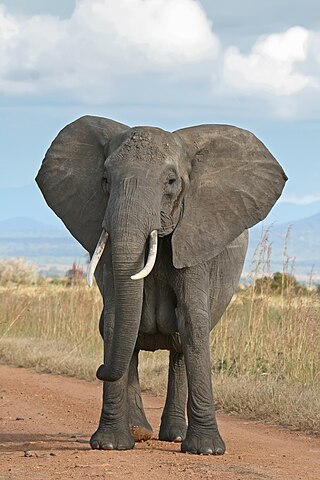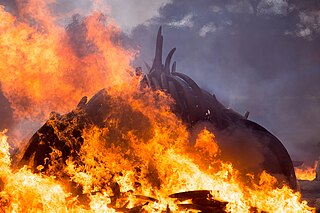Related Research Articles

Ivory is a hard, white material from the tusks and teeth of animals, that consists mainly of dentine, one of the physical structures of teeth and tusks. The chemical structure of the teeth and tusks of mammals is the same, regardless of the species of origin, but ivory contains structures of mineralised collagen. The trade in certain teeth and tusks other than elephant is well established and widespread; therefore, "ivory" can correctly be used to describe any mammalian teeth or tusks of commercial interest which are large enough to be carved or scrimshawed.

Poaching is the illegal hunting or capturing of wild animals, usually associated with land use rights. Poaching was once performed by impoverished peasants for subsistence purposes and to supplement meager diets. It was set against the hunting privileges of nobility and territorial rulers.
J. Michael Fay is an American ecologist and conservationist notable for, among other things, the MegaTransect, in which he spent 455 days walking 2,000 miles across Africa and the MegaFlyover in which he and pilot Peter Ragg spent months flying 70,000 miles in a small plane at low altitude, taking photographs every twenty seconds. Both projects were sponsored by the National Geographic Society, which produced articles and documentaries about the projects.
Zakouma National Park is a 3,000 km2 (1,158 sq mi) national park in southeastern Chad, straddling the border of Guéra Region and Salamat Region. Zakouma is the nation's oldest national park, declared a national park in 1963 by presidential decree, giving it the highest form of protection available under the nation's laws. It has been managed by the nonprofit conservation organization African Parks since 2010 in partnership with Chad's government.
Bahr Salamat Faunal Reserve is a conservation area in Chad. It is named after the Bahr Salamat River which flows through it. The area was designated 1 January 1964 and is classed as IUCN category IV.

Garamba National Park is a national park in the north-eastern Democratic Republic of the Congo covering nearly 5,200 km2 (2,000 sq mi). It is among Africa's oldest parks and was designated a World Heritage Site by UNESCO in 1980 for its protection of critical habitat for northern white rhinoceroses, African elephants, hippopotamuses, and giraffes. Garamba National Park has been managed by African Parks in partnership with the Institut Congolais pour la Conservation de la Nature since 2005.

Environmental issues in Kenya include deforestation, soil erosion, desertification, water shortage and degraded water quality, flooding, poaching, and domestic and industrial pollution.

The wildlife of Chad is composed of its flora and fauna. Bush elephants, West African lions, buffalo, hippopotamuses, Kordofan giraffes, antelopes, African leopards, cheetahs, hyenas, and many species of snakes are found there, although most large carnivore populations have been drastically reduced since the early 20th century. Elephant poaching, particularly in the south of the country in areas such as Zakouma National Park, is a severe problem.

Dr. Iain Douglas-HamiltonCBE is a Scottish zoologist from Oxford University and one of the world's foremost authorities on the African elephant. Douglas-Hamilton pioneered the first in-depth scientific study of elephant social behaviour in Tanzania's Lake Manyara National Park, aged 23. His work in the 1960s paved the way for much of today’s understanding of elephants and current conservation practices. During the 1970s he investigated the status of elephants throughout Africa and was the first to alert the world to the ivory poaching holocaust, bringing about the first global ivory trade ban in 1989. In 1993, Douglas-Hamilton founded Save the Elephants, which is dedicated to securing a future for elephants and their habitats. For his work on elephants he was awarded two of conservation's highest awards - the Order of the Golden Ark in 1988, the Order of the British Empire in 1992, and the Commander of the British Empire (CBE) in 2015. In 2010, he was named the recipient of the Indianapolis Prize, the world's leading award for animal conservation. In May 2012, Douglas-Hamilton spoke at the Senate Foreign Relations Committee hearing on Ivory and Insecurity: The Global Implications of Poaching in Africa.
Bouba Njida National Park is a national park of Cameroon. A total of 23 antelope species occur in the park. The painted hunting dog, Lycaon pictus, had been observed in Bouba Njida National Park at the start of the 21st century. This population of the endangered canid is one of the few that remained in Cameroon as of the year 2000.

The African bush elephant, also known as the African savanna elephant, is one of two extant African elephant species and one of three extant elephant species. It is the largest living terrestrial animal, with bulls reaching a shoulder height of up to 3.96 m and a body mass of up to 10.4 t.

African Parks is a non-governmental organization (NGO) focused on conservation, established in 2000 and headquartered in Johannesburg, South Africa. It was founded as the African Parks Management and Finance Company, a private company, then underwent structural changes to become an NGO called African Parks Foundation, and later renamed African Parks Network. The organization manages national parks and protected areas throughout Africa, in collaboration with governments and surrounding communities. African Parks manages 22 protected areas in 12 countries as of May 2023, and employs more than 1,100 rangers. Michael Eustace, Peter Fearnhead, Paul Fentener van Vlissingen, Anthony Hall-Martin, and Mavuso Msimang are credited as co-founders; Fearnhead continues to serve as chief executive officer. Prince Harry was appointed African Parks' president in late 2017.

The ivory trade is the commercial, often illegal trade in the ivory tusks of the hippopotamus, walrus, narwhal, black and white rhinos, mammoth, and most commonly, African and Asian elephants.

Elephant hunting, which used to be an accepted activity in Kenya, was banned in 1973, as was the ivory trade. Poaching continues, as there is still international demand for elephant tusks. Kenya pioneered the destruction of ivory as a way to combat this black market. Elephant poaching continues to pose a threat to the population.

Elephant hunting or elephant poaching and exploitation of the ivory trade are illegal in Chad and pose a major threat to elephant populations. The profitable ivory industry is also a threat to the lives of rangers, even in the national parks, such as Zakouma National Park, the worst-affected area.

Satao was one of Kenya's largest African elephants. He was known as a tusker because his tusks were so long that they almost touched the ground. The Tsavo Trust announced that Satao was killed by poachers using a poisoned arrow on 30 May 2014.

The destruction of ivory is a technique used by governments and conservation groups to deter the poaching of elephants for their tusks and to suppress the illegal ivory trade. As of 2016, more than 263 tonnes (580,000 lb) of ivory have been destroyed, typically by burning or crushing, in these high-profile events in 21 countries around the world. Kenya held the first event in 1989, as well as the largest event in 2016, when a total of 105 tonnes (231,000 lb) of ivory were incinerated.

Many species are affected by poaching, including illegal hunting, fishing and capturing of wild animals, and, in a recent usage, the illegal harvesting of wild plant species. The article provides an overview of species currently endangered or impaired by poaching in the Americas, sub-Saharan Africa, and South-East Asia.
Chinko, also known as Chinko Nature Reserve and the Chinko Project Area, is a protected area in the Central African Republic. The nonprofit conservation organization African Parks began managing Chinko in partnership with the government of the Central African Republic in December 2014.
The Big Life Foundation is a non-profit conservation organization focused on preserving the wildlife and habitats of the Amboseli-Tsavo-Kilimanjaro ecosystem of East Africa through community-based and collaborative strategies.
References
- 1 2 3 4 5 "Widespread elephant slaughter discovered in Chad" Archived 2007-03-12 at the Wayback Machine – August 30, 2006 Wildlife Conservation Society Press Release
- ↑ "A Nation of Tragedies", news.mongabay.com. Accessed 12 January 2024.
- ↑ "National Geographic reporting source describing use of automatic weapons". Archived from the original on 2006-09-01. Retrieved 2006-09-01.
- ↑ Ivory trade (PDF) bornfree.org